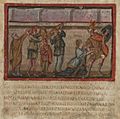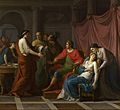Aeneid facts for kids

The Aeneid (Latin: Aeneis) is a very famous epic poem from ancient Rome. It was written by a poet named Virgil between 29 BC and 19 BC. This long poem tells the exciting story of a brave Trojan hero called "pious Aeneas".
Contents
The Aeneid: An Epic Journey
The Aeneid is one of the most important poems from ancient Rome. It tells the amazing adventures of Aeneas. He was a Trojan warrior who had to leave his home. The Greeks had captured his city, Troy, after a long and famous war.
Aeneas: A Hero's Escape
The story begins with Aeneas escaping from burning Troy. He carries his old father, Anchises, on his shoulders. His young son, Ascanius, walks beside him. Aeneas leads his people on a long journey across the sea. They are searching for a new home.
Aeneas's Adventures and Destiny
Aeneas and his followers face many dangers. They travel to different lands. They meet new people and overcome big challenges. The gods often guide Aeneas. They tell him his destiny is to found a new city. This city will one day become the great city of Rome.
The poem ends with Aeneas landing on the shores of Italy. Here, he fights battles in the region where Rome would later be built. His journey is not just about finding a new home. It is also about fulfilling a grand destiny for his people.
Why Was the Aeneid Written?
The Aeneid can be read as a way to support Augustus. He was the first Roman emperor. Virgil wrote the poem during Augustus's rule. The story connects Aeneas, a legendary hero, to the founding of Rome. It also links him to Augustus's family. This helped to make Augustus's rule seem important and chosen by the gods. It showed that Rome had a long and glorious past.
How the Aeneid Was Written
Virgil wrote the Aeneid using a special type of poetry. It is called hexameters. This means each line of the poem follows a specific rhythm. It makes the poem sound grand and important when read aloud. The Aeneid is still studied today. It teaches us a lot about Roman history, myths, and values.
Images for kids
-
Paul Cézanne, Aeneas Meeting Dido at Carthage, c. 1875, Princeton University Art Museum
-
Virgil, holding a manuscript of the Aeneid, flanked by the muses Clio (history) and Melpomene (tragedy). Roman mosaic, third century AD, from Hadrumetum, now in the Bardo Museum, Tunis.
-
Virgil Reading the Aeneid to Augustus and Octavia, by Jean-Joseph Taillasson, 1787, an early neoclassical painting (National Gallery, London)
See also
 In Spanish: Eneida para niños
In Spanish: Eneida para niños






